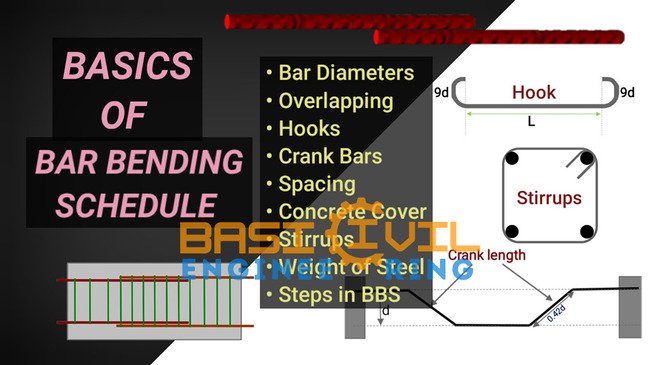Bar Bending Schedule Formulas: How to Calculate Reinforcement Bar

Bar Bending Formulas: How to Calculate Reinforcement Rebar
Bar Bending Schedule (BBS) is a detailed list of reinforcement bars, their quantity, shape, size, and location in a structure. BBS is an essential part of the construction as it provides contractors and engineers with a clear understanding of the amount of steel required for a structure. This helps in the estimation of the cost of the project, reducing wastage and improving the quality of the construction.
Bar Bending Schedule Formulas
Calculating Bar Bending Schedule requires a good understanding of the formulas used to calculate different aspects of steel bars. Here are some essential Bar Bending Schedule formulas:
Formula for Straight Length of Bar
The straight length of a bar is calculated by adding the development length and the lap length. The formula is as follows:
Straight length = Development length + Lap length
Formula for Bending Length of Bar
The bending length of a bar is calculated based on the diameter of the bar, the angle of bending, and the radius of the bend. The formula is as follows:
Bending length = (Diameter of Bar/2) x Total Bend Angle x (π/180) x Bend Radius
Formula for Cutting Length of Bar
The cutting length of a bar is calculated by adding the clear cover, hook length, and the structural member’s dimension to the bar’s bending length. The formula is as follows:
Cutting length = Bending length + Clear cover + Hook length + Dimension of the structural member
Formula for Weight of Steel Bar
The weight of a steel bar is calculated based on its diameter and length. The formula is as follows:
Weight of Steel Bar = ((Diameter^2)/162) x Length
Steps to Calculate Bar Bending Schedule
Calculating Bar Bending Schedule involves the following steps:
Identify the Structure and Its Drawing
The first step in calculating Bar Bending Schedule is carefully studying the structural drawings to determine the quantity, size, and placement of the structure’s required reinforcement bars.
Count the Reinforcement Bars
The second step is to count the number of reinforcement bars required for the structure based on the structural drawings. This includes determining the diameter, shape, and length of each bar.
Calculate the Bending Length of the Bar
Once the number and diameter of the reinforcement bars are determined, the next step is to calculate the bending length of the bars. This is done using the formula mentioned above.
Calculate the Cutting Length of the Bar
The cutting length of the bar is calculated based on the bending length, clear cover, hook length, and the dimension of the structural member using the formula mentioned above.
Calculate the Weight of the Steel Bar
The weight of the steel bar is calculated based on its diameter and length using the formula mentioned above.
Read More
-
Types of the Roads or Classification of Roads
-
What are the various types of structural loads?
-
Components, Transportation, and Storage of Rainwater Harvesting Methods
-
How to Calculate Cutting Length of Stirrups in columns
-
Concrete Compressive Strength -Cube Test [PDF], Procedure, and Results
FAQs:
Q: What is Bar Bending Schedule (BBS)?
A: Bar Bending Schedule (BBS) is a detailed list of reinforcement bars, their quantity, shape, size, and location in a structure. It is used to estimate the amount of steel required for a structure, which helps estimate the project’s cost, reduce wastage, and improve the quality of the construction.
Q: Why is Bar Bending Schedule important in construction?
A: Bar Bending Schedule is essential in construction because it provides contractors and engineers with a clear understanding of the amount of steel required for a structure. This helps in the estimation of the cost of the project, reducing wastage, and improving the quality of the construction.
Q: What are the formulas used to calculate Bar Bending Schedule?
A: The formulas used to calculate different aspects of steel bars for the Bar Bending Schedule include the straight length, bending length, cutting length, and weight of the steel bar.
Q: How is the straight length of a reinforcement bar calculated?
A: The straight length of a bar is calculated by adding the development length and the lap length.
Q: How is the bending length of a reinforcement bar calculated?
A: The bending length of a bar is calculated based on the diameter of the bar, the angle of bending, and the radius of the bend.
Q: How is the cutting length of a reinforcement bar calculated?
A: The cutting length of a bar is calculated by adding the clear cover, hook length, and the structural member’s dimension to the bar’s bending length.
Q: How is the weight of a steel bar calculated?
A: The weight of a steel bar is calculated based on its diameter and length.
Q: What are the steps involved in calculating Bar Bending Schedule?
A: The steps involved in calculating Bar Bending Schedule include identifying the structure and its drawing, counting the reinforcement bars, calculating the bending length of the bar, calculating the cutting length of the bar, and calculating the weight of the steel bar.
Q: How can I use Bar Bending Schedule formulas in construction projects?
A: By following the step-by-step guide mentioned in the blog post, engineers and contractors can easily use Bar Bending Schedule formulas in their construction projects to estimate the amount of steel required for a structure, reducing wastage and improving the quality of the construction.
Conclusion
In conclusion, Bar Bending Schedule is an essential part of construction that helps estimate the project’s cost, reduce wastage, and improve the construction’s quality. Calculating Bar Bending Schedule involves a good understanding of the formulas used to calculate different aspects of steel bars, including the straight length, bending length, cutting length, and steel bar weight. Following the step-by-step guide mentioned above, engineers and contractors can easily calculate Bar Bending Schedule for their construction projects.


